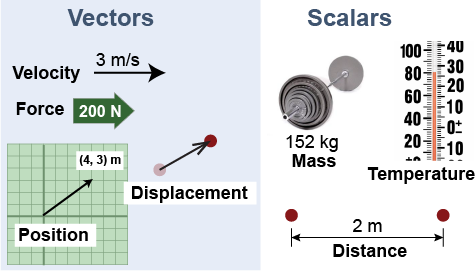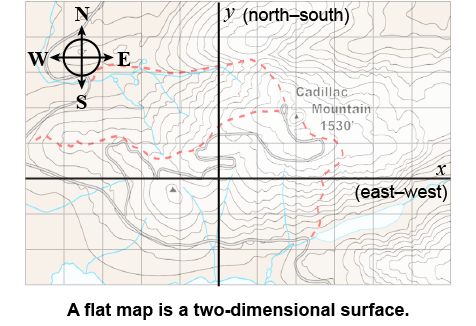|
A vector is a type of variable that includes information about direction as well as size. Unlike words such as “right” and “left,” a vector includes direction information in a mathematical way so that vectors in different directions can be added and subtracted. 
|
 A scalar does not depend on direction and can be completely specified with a single value. Distance, mass, and temperature are all scalar variables. Each can be completely described by a single value that does not include directional information. A distance can be zero but cannot be negative! The same is true of mass.
A scalar does not depend on direction and can be completely specified with a single value. Distance, mass, and temperature are all scalar variables. Each can be completely described by a single value that does not include directional information. A distance can be zero but cannot be negative! The same is true of mass. 
 |
Temperature (a scalar) can be negative in Celsius and Fahrenheit because on these scales the freezing point of water has been arbitrarily chosen as either 0°C or 32°F. For absolute temperature, however, the state of zero energy is chosen as zero degrees and we use the Kelvin scale. Temperature in units of kelvins must be positive and cannot be negative. 
|
Displacement is a vector even though distance is not. A displacement of 10 m tells you to move 10 m to the right in the coordinate system of the diagram below. A displacement of −10 m is a movement of 10 m to the left. With a vector, the positive and negative signs carry direction information. 
|

|
The magnitude of a vector is its “length” and is independent of its direction. For example, the displacements of +10 m and −10 m both have a magnitude of 10 m. Distance is the magnitude of both the position and displacement vectors. Other vectors such as force have magnitudes expressed in other units (such as newtons). The magnitude of any vector can be zero or positive but cannot be negative. 
|
 Position and displacement may be used when mapping landmarks or plotting a course. A map is a two-dimensional surface that has length and width. The north–south axis provides one perpendicular reference line, usually aligned with the y-axis. The east–west axis provides the second perpendicular reference line, usually aligned with the x-axis. Where the two axes meet is usually the origin or fixed reference point, such as zero degrees latitude and longitude on a map of the world. Using these two axes, every point on the surface can be uniquely identified with two numbers, x and y. A map is two dimensional because it takes two numbers to uniquely specify any point.
Position and displacement may be used when mapping landmarks or plotting a course. A map is a two-dimensional surface that has length and width. The north–south axis provides one perpendicular reference line, usually aligned with the y-axis. The east–west axis provides the second perpendicular reference line, usually aligned with the x-axis. Where the two axes meet is usually the origin or fixed reference point, such as zero degrees latitude and longitude on a map of the world. Using these two axes, every point on the surface can be uniquely identified with two numbers, x and y. A map is two dimensional because it takes two numbers to uniquely specify any point. 
|
Is density an example of a vector or scalar quantity?
 |
Density is an example of a scalar quantity. It lacks direction. It is also the product of mass and volume, both of which are scalar quantities. 
|

